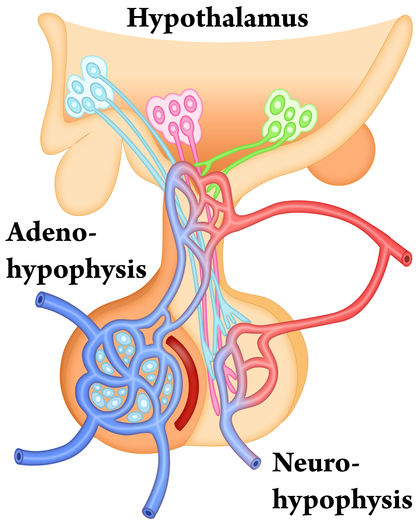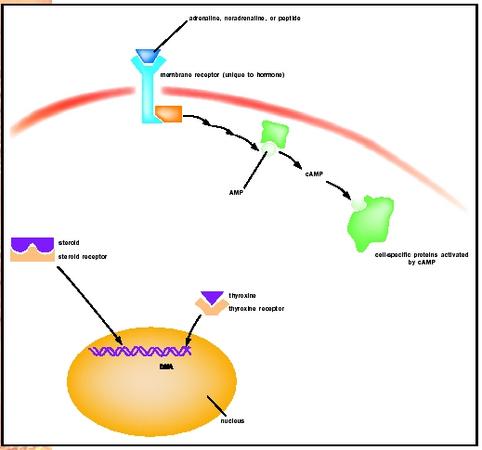Hormones

Hormones are molecules released by a group of cells in the body that influence the behavior of another group of cells. Hormones are the chemical signals of the endocrine system, the group of glands that, along with the nervous system, controls the body's responses to internal and external stimuli. Hormones are carried to their target cells in the bloodstream.
All hormones bind at the target cell to a specific receptor, a protein made by the target cell. When the hormone binds to the receptor, it causes a change in the receptor's conformation , or shape. This conformation change allows the receptor to fit with other cell molecules in a way it could not before, thus triggering new activities in the cell. While a hormone such as testosterone (produced in the testes) reaches all cells in the body, only some cells have testosterone receptors, and therefore only those cells are sensitive to testosterone's effects. Similarly, different receiving cells make different sets of molecules to interact with the testosterone receptor, and this controls the exact response the target cell exhibits.

Hormones are classified based on their chemical structures. Peptide hormones are chains of amino acids . Insulin and glucagon, which help control blood sugar, are peptide hormones, as are the hormones of the hypothalamus and the pituitary gland. Steroid hormones are lipids (fatlike molecules) whose structures are derived from cholesterol. Hormones of the sex organs and the adrenal cortex (part of the adrenal gland) are steroids. Monoamine hormones are made by modifying amino acids. These hormones include adrenaline and noradrenaline made by the adrenal medulla, thyroid hormone (thyroxine), and melatonin from the pineal gland in the brain.
Hormones also differ in where their receptors are found in the target cell, and the type of effect they cause when they bind to their receptors. The receptor for thyroxine is located in the nucleus , while the receptors for steroid hormones are found in the cell's cytoplasm . In both cases, the hormone binds to the receptor to form a complex, and then the hormone-receptor complex activates specific genes within the nucleus, leading to synthesis of new proteins.
Adrenaline, noradrenaline, and the peptide hormones do not enter the target cell. Instead, they bind to a receptor on the membrane surface. The receptor extends through the membrane, and when the outside portion binds to the hormone, the inside portion of the receptor undergoes a conformation change. This change sets off a cascade of reactions inside the cell, ultimately leading to an increase in concentration of one or another internal messenger molecules. The most common of these so-called "second messengers" (the hormone is the "first messenger") are calcium ion and cyclic AMP (cAMP), a type of nucleotide . The second messenger then triggers other activities in the cell, depending on the cell type. In muscle, adrenaline causes cAMP buildup, which causes breakdown of glycogen to release glucose , which the muscle cell uses to support increased activity.
Hormones that bind to external receptors and work through second messengers affect pre-existing proteins within the cell. Because of this, they typically cause much faster effects than those that bind to internal receptors, which influence creation of new proteins. For example, adrenaline's effects last from minutes to hours at the most, while testosterone's effects last from days to months or more.
SEE ALSO Adrenal Gland ; Amino Acid ; Blood Sugar Regulation ; Endocrine System ; Female Reproductive System ; Homeostasis ; Hypothalamus ; Male Reproductive System ; Nucleotides ; Pancreas ; Pituitary Gland ; Thyroid Gland ; Transcription
Richard Robinson
Bibliography
Alberts, Bruce, et al. Molecular Biology of the Cell, 4th ed. New York: Garland Publishing, 2000.
Saladin, Kenneth S. Anatomy and Physiology: The Unity of Form and Function. Dubuque, IA: McGraw-Hill Higher Education, 2001.
Comment about this article, ask questions, or add new information about this topic: